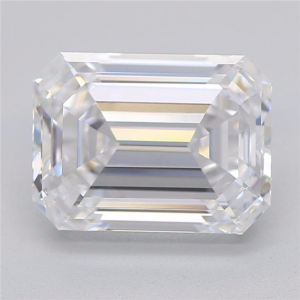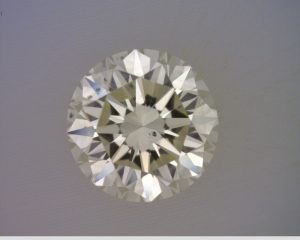Identifying Diamond Clarity
Diamond clarity refers to the presence or absence of tiny imperfections (inclusions) within the diamond. There are many different types of diamond inclusions and grades that correspond with diamond clarity. For example, determining diamond clarity can be tricky depending on the type of diamond inclusions the diamond has. Additionally, using a
diamond loupe is required to identify inclusions. it is important to learn and understand the clarity designations found within the "Four C's" diamond grading system. The inclusions and/or blemishes found within or on a diamond naturally form over time predominantly due to the penetration of heat during the formation process of the diamond itself. Thereby it is due to natural selection that some diamonds have more blemishes and/or diamond inclusions than others.
Using a Diamond Loupe to Identify Diamond Inclusions
Understanding diamond clarity is important to know how much value a diamond is worth. Additionally, the value of the
diamond directly corresponds to the visual appearance to the bare eye versus using a
diamond loupe. The internal characteristics of a diamond called diamond inclusions. For example, using a diamond loupe one would be better able to view the diamond inclusions inside the diamond to determine the value of grading. Blemishes are a superficial type of diamond inclusions.
Diamond Loupe and 10x Magnification
Almost all professional jewelers and gemologists have a diamond loupe, also know as the "jeweler’s loupe.” The diamond loupe is a magnifying glass that uses an 18-21mm lens and is used to identify the diamond's clarity. The standard diamond loupe provides a 10X magnification and typically this is sufficient for inspecting diamond inclusions. As well as a host of other applications. Well-known places to buy a jewelers diamond loupe can be found at either
Kassoy and
Jewelry Supply or even
Amazon. The best type of diamond loupe for inspecting diamond clarity would be an achromatic, aplanatic triplet lens. The cost of one of these items is usually between $20-$30.
Using a Diamond Loupe
A few reasons as to why one would want to learn how to use a diamond loupe. When buying a diamond a consumer would be able to easily see the difference between VS and SI or I1 clarity diamonds. For example, learning about a
feather inclusion on diamond versus a carbon inclusion would be useful in determining the value. Or using a diamond loupe to confirm the
clarity plot. Additionally, one would be better able identify the diamond inclusions to the naked eye after inspecting with a diamond loupe. In other words to see if the diamond is
eye-clean.
Using a Diamond Loupe to Determine the Diamond Cut
A useful application for using a diamond loupe is to view the
diamond cut. Aside from observing the diamond clarity and
diamond cut another useful application for the diamond loupe is to determine if the diamond has
hearts and arrows. As well as viewing if the diamond is
laser inscribed and matches the report number for a additional
verification.
Diamond Inclusions Types
One of the most important of the four C's of diamond grading are diamond inclusions. The others being
carat,
color, and
cut. Diamond
Inclusions are trapped during the stones formation. The diamond inclusions are either solids, liquids, or gases. Moreover, these diamond inclusions can even be crystals of a foreign material or even another diamond crystal. Additionally, they may produce structure type of inclusions. These may appear in the form of cracks milkiness that make a diamond appear whitish or cloudy. The visibility of these diamond inclusions, the number, size, color, relative location, orientation, can all affect diamond clarity. A diamond clarity grade is given on the overall look of the diamond under 10x magnification using the diamond loupe.
Diamond Clarity and High-Quality Diamonds
Diamond inclusions inside high-quality diamonds that are "eye-clean" or invisible to the eye without any assistance from the diamond loupe. It is important to note that each diamond inclusion can affect the diamond clarity grade. For example, large clouds can affect the stones ability to reflect light. Additionally, large cracks close to or breaking the surface may reduce a diamond's resistance to breaking. Stones with better diamond clarity grades are more rare and valuable. For example, the "Flawless" grade of diamond is the most expensive diamond clarity grade. Additionally, the flawless diamond clarity brings most valuable.
Diamond Inclusions and Identifying Markers
Diamond inclusions are important in determining value. However, they are also useful in that these diamond inclusions can identify them, similar to a fingerprint. Moreover, with the popularity of the
synthetic diamond market on the rise, these inclusions help distinguish between natural and synthetic diamonds.
Recognizing Diamond Inclusions
Determining diamond clarity is done with a 10 x magnification. It is important to know what type of diamond inclusions inside the diamond. Higher magnifications and viewing from other angles are also used during the grading process. This is done to identify the small inclusions found inside a diamond. Also, in "colorless" diamonds, darker inclusions will tend to create the most significant drop in clarity grade. Likewise, in fancy-colored diamonds, light or pale inclusions may show greater relief, making them more apparent, causing a greater drop in grade.
Considerations in grading the clarity of a diamond include the type of stone, point size and the location of inclusions. An important detail to keep in mind is that inclusions that are near to, or break the surface, may weaken the diamond structurally, therefore reducing its value significantly. On the other hand, it may be possible to hide certain inclusions behind the setting of the diamond (depending on where the inclusion is located).
Diamond Clarity Designations
FL - "Flawless"
IF - "Internally Flawless"
VVS-1 - "Very Very Small" inclusions, better than VVS2
VVS-2 - "Very Very Small" inclusions. VVS1 better than VVS2
VS-1 - "Very Small" inclusions
VS-2 - "Very Small" inclusions VS1 is a better grade than VS2
SI-1 - "Slight" Inclusions or "Imperfections" may be "eye clean"
SI-2 - "Slight" Inclusions or "Imperfections" visible to the naked eye
SI-3 - Better than I1, inclusions large and obvious (Not recognized by G.I.A.)
I1 to I3 - Imperfect, with large Inclusions, fractures, and flaws
Types of Diamond Inclusions
There are many different types inclusion that one should know when talking about diamond clarity. For example, bearding inclusions are hair-like that appear at the girdle. Furthermore, it comes from improper bruting processes. A heavily bearded girdle can give a hazy appearance to the diamond. Grain is an abnormal crystal growth. Internal graining is white or reflective lines. A cavity is usually on the surface of the diamond. For example, here is a list of types of diamond inclusions. Clouds, feathers, included crystals or minerals, knots, cavities, cleavage, bearding, internal graining, pinpoint, laser lines and twinning wisps. As well as, polish lines, grain boundaries, naturals, scratches, nicks, pits, chips, breaks, and dark and light spots.
The Gemological Institute of America uses the term "internal characteristics" for diamond inclusions.
Determining Diamond Clarity
For example, crystals can come in many different sizes and colors. Moreover, they are minerals that are present inside the diamond naturally. A cloud can cover a broad spectrum of inclusions that cluster together, such as pinpoints and twinning wisps. Additionally, a feather is a small break within the diamond and appears white in color. The needle type of inclusion is a long inclusion that resembles a needle. The twinning wisps type of inclusions is a result of an abnormal crystal structure. For example, this happens during the formation process. A chip is an opening on the surface of a diamond.
Fancy Color Diamonds
Pink Diamonds
Jewelry Industry Technology
Diamonds Suffer
Diamonds Suffer
Diamond Cutters
GIA
ALROSA Diamond News
ALROSA Diamond News
Princess Cut Diamonds
Grading Diamonds
Diamond Price List
Diamond Tennis Necklaces
Buying Loose Diamonds
Diamond Trading
Buying Diamond Engagement Rings
Four Diamond C's
Diamond Info
Diamond Certificates
ALROSA Diamond Mining Company
Diamond Sales

Determining diamond clarity is done at the laboratory at the GIA facilities.

Diamond Inclusions are formed naturally during the diamonds growth process.

Flawless is the best Diamond Clarity